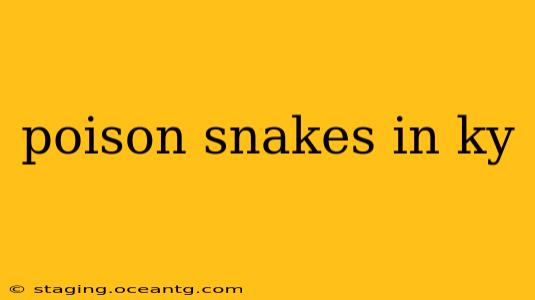Kentucky, with its diverse landscape ranging from forested hills to sprawling plains, is home to a number of snake species. While most are harmless, a few venomous snakes pose a potential threat. Understanding which snakes are poisonous and how to react to an encounter is crucial for both residents and visitors. This guide provides a comprehensive overview of poisonous snakes found in Kentucky, focusing on identification, habitat, and safety measures.
What types of venomous snakes live in Kentucky?
Kentucky has only three venomous snake species: the copperhead, the timber rattlesnake, and the cottonmouth (water moccasin). It's important to distinguish these from non-venomous snakes, as misidentification can lead to unnecessary fear or dangerous situations.
Copperhead ( Agkistrodon contortrix)
The copperhead is arguably the most common venomous snake in Kentucky. Its distinctive features include a copper-colored head (hence the name), hourglass-shaped markings along its back, and a relatively stout body. They are ambush predators, often found near rocks, logs, and leaf litter. Copperheads are generally shy and will try to avoid confrontation, but they will strike if threatened.
Timber Rattlesnake (Crotalus horridus)
The timber rattlesnake is Kentucky's largest venomous snake. They are easily identifiable by their large size, dark brown or grayish-black coloration with lighter crossbands, and a characteristic rattle at the end of their tail. These snakes prefer rocky areas, wooded slopes, and mountainous regions. Unlike copperheads, timber rattlesnakes are not always shy and may be more aggressive if cornered.
Cottonmouth (Water Moccasin) (Agkistrodon piscivorus)
The cottonmouth, also known as the water moccasin, is found near water sources, such as swamps, rivers, and lakes. They have a dark, almost black, body with a broad, dark head. Their most distinctive feature is their white or pale mouth lining, which they often display when threatened. Cottonmouths are more aggressive than copperheads and will readily strike if they feel threatened.
How can I identify a poisonous snake in Kentucky?
Identifying venomous snakes requires careful observation. Key features to look for include:
- Triangular Head: Venomous snakes often have a triangular-shaped head, broader than their neck.
- Heat-Sensing Pits: Rattlesnakes and copperheads possess heat-sensing pits between their eyes and nostrils, which are not present in non-venomous snakes.
- Rattle (Rattlesnakes Only): The presence of a rattle is a definitive characteristic of rattlesnakes.
- Distinct Markings: Look for specific patterns like hourglass markings (copperheads) or crossbands (timber rattlesnakes).
However, relying solely on visual identification can be unreliable. If you encounter a snake you suspect is venomous, it’s best to err on the side of caution and maintain a safe distance.
What should I do if I see a venomous snake?
- Maintain a safe distance: Do not approach or attempt to handle the snake. Give it plenty of space to retreat.
- Observe from afar: Try to get a good look at the snake's features to aid identification, but only from a safe distance.
- Alert others: Warn nearby people or children about the presence of the snake.
- Seek professional help: If you are bitten by a venomous snake, seek immediate medical attention. Note the characteristics of the snake if possible, as this information can aid treatment.
Are there any other poisonous snakes in Kentucky?
No. Aside from the copperhead, timber rattlesnake, and cottonmouth, there are no other venomous snake species in Kentucky. Many other snake species in Kentucky are non-venomous and pose no threat to humans.
What is the best way to avoid snakebites in Kentucky?
The best way to avoid snakebites is to be aware of your surroundings and take preventative measures:
- Wear appropriate footwear: When hiking or walking in areas where snakes are common, wear sturdy boots to protect your feet.
- Use caution near rocks, logs, and leaf litter: Snakes often seek shelter in these places.
- Keep a safe distance from water sources: Cottonmouths inhabit areas near water.
- Never handle snakes: Always admire snakes from a safe distance.
- Be extra cautious at night: Snakes are more active at night.
This guide provides crucial information regarding poisonous snakes in Kentucky. Remember, responsible behavior and awareness are vital to ensure a safe coexistence with Kentucky's diverse wildlife. If you have any concerns or encounter a snake you are unsure of, it's always best to contact a wildlife expert or your local health department.
